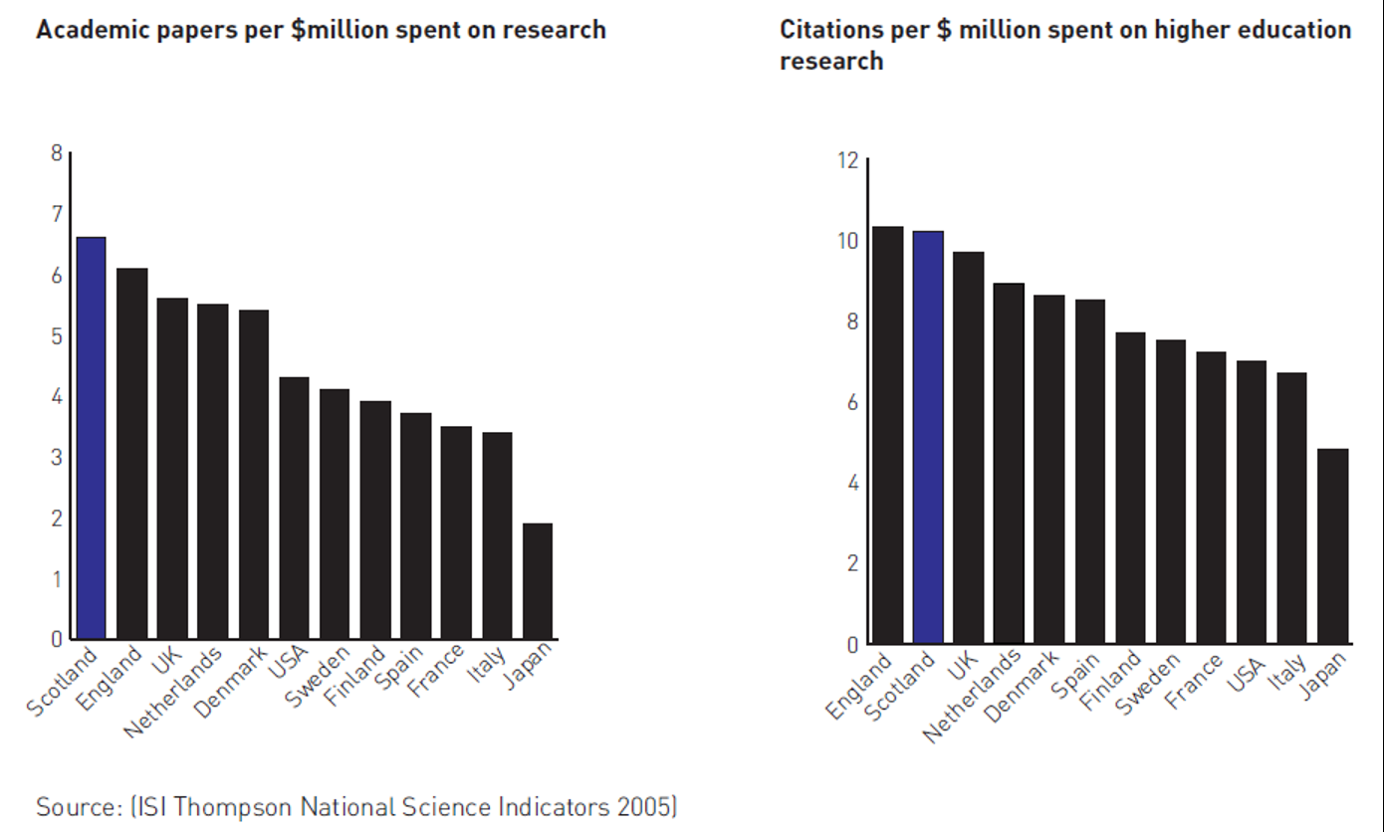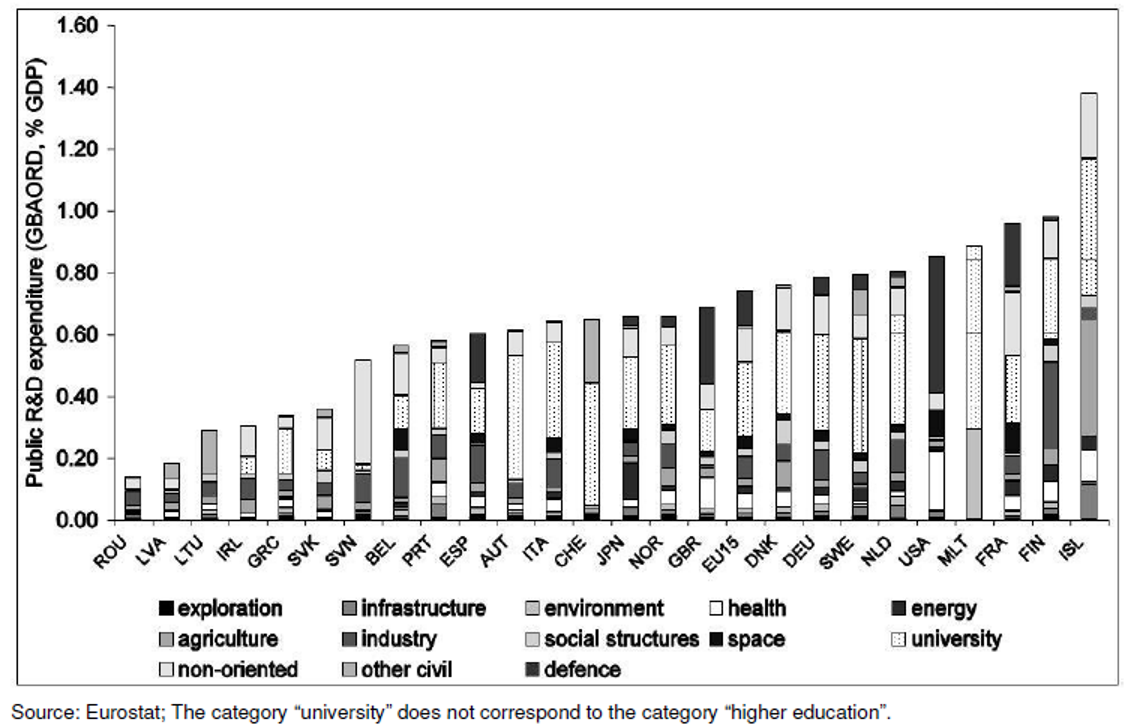- Research efficiency in different countries
Data on investment required per paper, or per citation again shows that the UK is most efficient.
again shows that the UK is most efficient.
A recent review (2013) discussing why this might be [https://www.gov.uk/government/publications/performance-of-the-uk-research-base-international-comparison-2013] suggests factors like mobility. It notes while the UK represents just 0.9% of global population, 3.2% of R&D expenditure, and 4.1% of researchers, it accounts for 9.5% of downloads, 11.6% of citations and 15.9% of the world’s most highly-cited articles. Amongst its comparator countries, the UK has overtaken the US to rank 1st by field-weighted citation impact (an indicator of research quality). Moreover, with just 2.4% of global patent applications, the UK’s share of citations from patents (both applications and granted) to journal articles is 10.9%. The UK science minister Jo Johnson [https://www.gov.uk/government/speeches/making-britain-the-best-place-in-the-world-for-science] states “with 3.2% of the world’s R&D spend, the UK accounts for 16% of the most highly-cited research articles. Around half of all UK research publications involve collaborations with other countries. Papers involving international collaboration have almost twice the citation impact of those produced by a single UK author. And EU countries are among our most crucial partners, representing nearly 50% of all our overseas collaborators.”
More discussions on the UK [http://www.parliament.uk/documents/lords-committees/science-technology/InnovateUK/InnovateUK.pdf, p39,66]. One suggestion is that the UK publishes research in more accessible forms than elsewhere, and that it has wide ranging strength rather than individual specialism. The UK is seen as a ‘collaboration hub’ where other countries use UK to work together.Other discussions can be found in:
– http://www.sciencedirect.com/science/article/pii/S0048733311001752,
– https://ec.europa.eu/jrc/en/publication/eur-scientific-and-technical-research-reports/research-performance-based-funding-systems-comparative-assessment,
– http://journals.plos.org/plosone/article?id=10.1371/journal.pone.0151328 (the impact of developing nations R&D research is lower than expected),
– http://www.scimagojr.com/countryrank.php?order=h&ord=desc (an H-Index for ranking countries, based on numbers of citations and papers, so ‘quality’ & ‘quantity’ of work, pushes China down rankings),
– http://www.sciencedirect.com/science/article/pii/S2405650216300132 (where top universities/journals are in neurology),
– http://journals.plos.org/plosone/article?id=10.1371/journal.pone.0109195#s2 (the impact of international collaboration, showing that the more countries involved the better research tends to be),- https://www.globalinnovationindex.org/analysis-indicator (an index of innovation),- https://www.globalinnovationindex.org/analysis-economy (a UK report, showing UK strength in creative output).Stefan Collini has noted the relative effectiveness of the UK, USA and Australia (with university based research systems) compared to France (CNRS), Germany (Max Planck, Fraunhofer etc) and other institute based systems. “The constant ‘refresh’ stimulated by research students and post-docs is one benefit. Another is the flexibility of principal investigators to re-direct their effort compared to a mission-based institute. English language may also be part of the answer. A competitive drive may be another part. History certainly plays into this, but our European neighbours have a comparable background.”He worries though about various biases that may be also at work. “UK Government reports look at trajectories where last year’s papers have one year’s citations and the papers of five years earlier have had more time for citations to accumulate. The annual data points are not like-for-like. When I track UK and e.g. China citations on a more comparable basis then the UK’s papers actually decline over time relative to world average, continuing to ‘do well’ but not nearly as well. China, however, progressively improves relative to that global average.“. He suggests that another part of the answer about UK research effectiveness may be that it (and the USA) tend to “publish, cite and move on rather quickly. Other countries appear to take time to digest their output and make the next step.“.
It would be interesting to do more work in understanding if this is true.In his 2016 book, The Politics of Innovation [https://www.insidehighered.com/news/2016/07/26/why-are-some-countries-better-science-and-technology], Mark Zachary Taylor found that government policies only part way explain how countries innovate. They leave an enormous amount of unexplained success and failure. He suggested that actually social networks are very important, “to take shortcuts around markets for access to high-quality science labor, technical knowledge, investment capital and even marketing expertise. Social networks provide vital information which neither free markets nor government institutions easily capture, but networks are often ignored due to our preoccupation with domestic institutions and policies. Also, because foreign information is often the most difficult knowledge to capture, international networks play important roles in national S&T performance. So explaining innovation is not just a domestic story, it also has an international side.” He also proposes a theory of “creative insecurity,” which holds that countries generally have higher innovation rates when the external threats they face exceed domestic political or economic tensions. This allows imperatives to propel technologies forward, even when it creates many losers or requires significant investment.
- Healthcare is about 10% of GDP in many countries, see http://www.nationmaster.com/graph/hea_tot_exp_as_of_gdp-health-total-expenditure-gdp . From OECD 2004, data the gross spend on R&D (‘GERD’) is about 1.7% (UK) to 3.5% (Japan) of GDP [UNESCO report], while government spend (‘GOVERD’) about 0.7% in the UK, hence 10x less than healthcare (~10%GDP).
- Comparison of general spending R&D on universities and defence:
 http://discutii.mfinante.ro/static/10/Mfp/buget/reformabugetue/5bStudyEUspendingen.pdf, (2008 report on EU spending). The UK and USA spend most %R&D on defence.
http://discutii.mfinante.ro/static/10/Mfp/buget/reformabugetue/5bStudyEUspendingen.pdf, (2008 report on EU spending). The UK and USA spend most %R&D on defence.